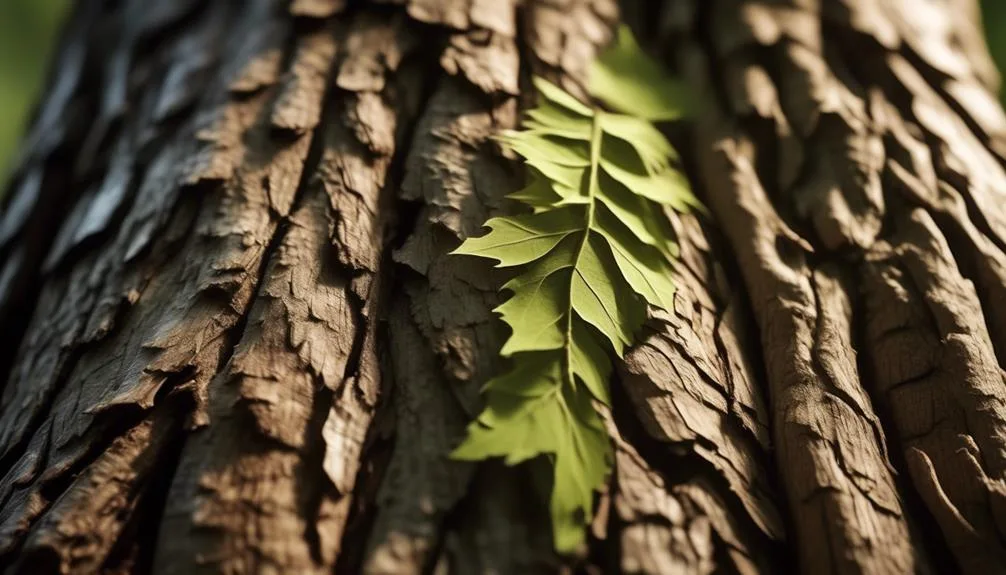Identifying different hickory tree species may seem overwhelming, but with a keen eye and understanding of key traits, it's easier than you think.
Each species has unique features, from bark patterns to nut shapes. Knowing these differences enriches your understanding of nature and has practical benefits.
Whether you're a nature lover or just curious about the trees around you, learning to identify different hickory tree species can be a rewarding exploration.
Carya Ovata (Shagbark Hickory) Identification
Identifying Carya Ovata, commonly known as Shagbark Hickory, is a key skill for tree enthusiasts, as its distinctive bark and unique characteristics make it a standout species in the forest landscape.
The most striking feature of Shagbark Hickory is its shaggy, peeling bark that curls away from the trunk in long, vertical strips, creating a rugged and textured appearance. This bark is a defining characteristic, making it relatively easy to identify even from a distance.
Additionally, Shagbark Hickory trees produce large, sweet-flavored nuts that are enclosed in thick, four-parted husks. These nuts are highly valued by both wildlife and humans for their rich flavor and nutritional value.
When identifying Shagbark Hickory, paying attention to the distinctive bark and the presence of these characteristic nuts is essential for accurate identification.
Carya Laciniosa (Shellbark Hickory) Identification
When you come across a Carya Laciniosa, also known as the Shellbark Hickory, pay attention to its distinctive shell-like bark and the large, sweet nuts it produces.
Identification Tips for Carya Laciniosa:
- Bark Characteristics: The bark of the Shellbark Hickory is known for its unique shaggy appearance, resembling the outer shell of a turtle. The plates of bark on mature trees can be up to 1 inch thick, with pronounced ridges and furrows.
- Nut Size and Shape: Shellbark Hickory nuts are among the largest of all hickory species, often reaching 2 inches in length. They've an oblong shape with a pointed tip and a sweet, edible kernel.
When identifying a Shellbark Hickory, look for these distinct features to differentiate it from other hickory tree species.
Carya Cordiformis (Bitternut Hickory) Identification
As you observe the distinctive shell-like bark of the Carya Laciniosa, also known as the Shellbark Hickory, your attention will now shift to the distinguishing features of Carya Cordiformis, commonly known as the Bitternut Hickory.
Bitternut Hickory leaves are characterized by their slender, spear-shaped appearance with finely serrated edges. The bark of the Bitternut Hickory tends to have narrow ridges that form a diamond-like pattern.
When identifying this hickory species, take note of the nut size, as Bitternut Hickory nuts are relatively small, with thin husks and a bitter taste. They're markedly smaller compared to other hickory species. The nuts are indeed bitter, as the name suggests, and aren't typically consumed raw due to their unpalatable taste, unlike the sweeter nuts of some other hickory species.
Carya Glabra (Pignut Hickory) Identification
The bark of the Pignut Hickory, known as Carya glabra, is characterized by its tight furrows and relatively smooth texture, which distinguishes it from other hickory species. When identifying a Pignut Hickory, look for these characteristics:
- Leaf Structure: The Pignut Hickory has compound leaves with 5 to 7 leaflets, each with finely serrated edges.
- Fruit: Its fruit is pear-shaped, with a husk that splits only about halfway down, and the nut is small and bitter, hence the name 'Pignut'.
- Habitat and Distribution: Pignut Hickories are commonly found in dry upland forests, especially in the eastern United States. They thrive in well-drained soils and are often seen alongside oaks and other hickory species.
Pignut Hickories aren't only identifiable by their bark but also by their distinctive leaves, fruit, and preferred habitat.
Carya Tomentosa (Mockernut Hickory) Identification
Pignut Hickories are not the only distinctive hickory trees; another notable species is the Mockernut Hickory, scientifically known as Carya tomentosa, which can be identified by its unique bark, leaves, and fruit. The bark of the Mockernut Hickory is characterized by deep furrows and tight ridges, forming a rough, scaly texture. Its leaves consist of 7 to 9 leaflets with serrated edges, and they emit a pungent odor when crushed. The nuts of the Mockernut Hickory are round and large, with a thick, hard shell. The kernel is sweet and edible, making it a valuable food source for wildlife. Below is a table summarizing the distinguishing features of the Mockernut Hickory:
| Characteristics | Description |
|---|---|
| Bark patterns | Deep furrows and tight ridges |
| Nut characteristics | Round, large, thick hard shell |
Conclusion
Next time you take a stroll in nature, keep an eye out for the unique features of different hickory tree species.
From the shaggy bark of the Shagbark Hickory to the distinct nuts of the Shellbark Hickory, each species has its own charm.
Happy exploring!

My interest in trees started when I first saw the giant sequoias in Yosemite.
I was a teenager then, and I remember thinking, “I need to learn more about this.”
That moment stuck with me.
A few years later, I went on to study forestry at Michigan Tech.
Since graduating, I’ve worked in a mix of hands-on tree care and community education.
I’ve spent over ten years helping people understand how to plant, maintain, and protect the trees in their neighborhoods.
I don’t see trees as just part of the landscape.
They are living things that make a real difference in our daily lives.
